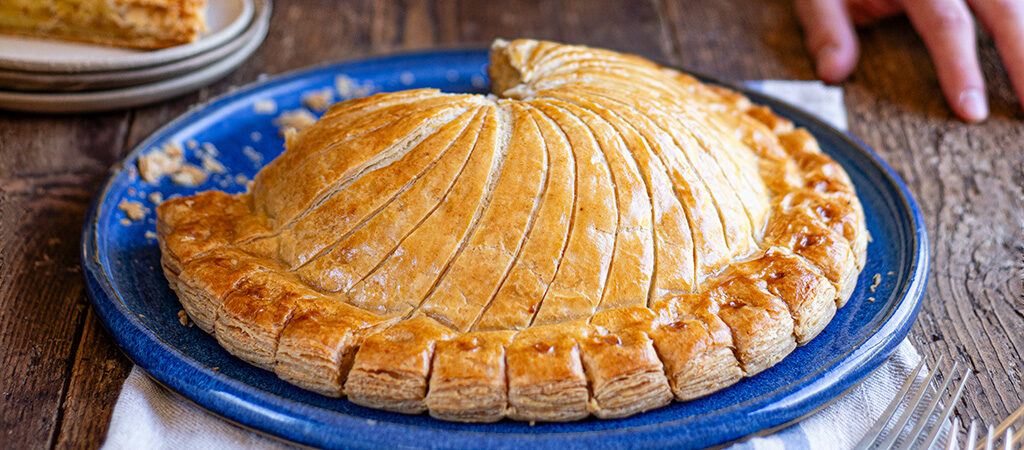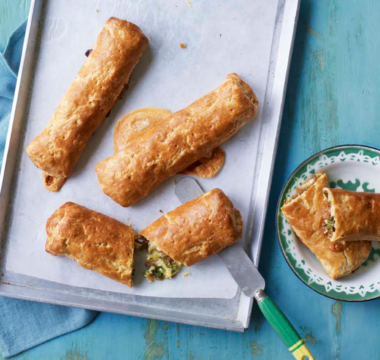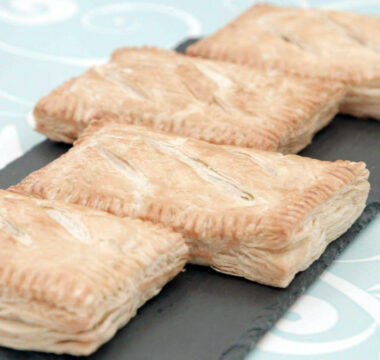This iteration of a 17th-century French pithivier (from the town of the same name) comprises dauphinoise encased in two discs of cheat’s rough puff. The creamy cooking liquid is reinvented as a rich roquefort sauce.


Paul Hollywood
Series 14
- Ingredients
- Method
Method
Step 1
Make the filling. Slice the potatoes very thinly either by hand or using a mandoline. Heat the cream, milk and garlic in a large pan. Add the potatoes, bring to the boil, then reduce the heat and simmer gently for 10-15 minutes, until the potatoes are tender but not soft. Drain the potatoes in a sieve, reserving the milky liquid. Spread the potatoes out on a large tray to cool, then chill until needed.
Step 2
Heat the oil and butter in a large frying pan. Add the onions and cook on a low heat until soft, translucent and lightly caramelised. Remove from the heat and leave to cool, then chill until needed.
Step 3
Make the cheat's rough puff. While the filing is chilling, mix the flour and salt together in a large bowl. Rub in the chilled butter using your fingertips until the mixture resembles breadcrumbs. Gradually add enough of the ice-cold water to form a ball of dough.
Step 4
Lightly flour the work surface and roll the dough out to a 45 x 15cm rectangle.
Step 5
Scatter half of the frozen grated butter over the bottom two-thirds of the dough. Fold down the top third and fold up the bottom third as if folding a letter.
Step 6
Turn the folded dough 90 degrees and roll it out again into a 45 x 15cm rectangle. Repeat the process, adding the remaining frozen butter and fold as before. Wrap the dough and leave it to chill in the freezer for 15 minutes, or fridge for 30 minutes.
Step 7
Repeat the rolling and folding process one more time, this time without the butter. Wrap the dough and leave it to chill in the freezer for 15 minutes, or fridge for 30 minutes.
Step 8
Assemble the pithivier. Lightly flour the work surface and roll out just under half (two-fifths) of the pastry until about 3mm thick, then cut out a 26cm-diameter disc. Place the disc on the lined baking sheet and cover it with a sheet of baking paper. Roll out the remaining pastry and cut a second disc, about 28cm in diameter. Set the larger disc aside.
Step 9
Layer the cold potatoes and onions on top of the smaller pastry disc, seasoning them between each layer with salt and pepper and a sprinkling of nutmeg. Aim to create a slightly domed shape and leave a 2cm border around the edge. Brush
the pastry border with beaten egg, then gently lay the larger
pastry disc over the filling. Press the edges firmly together
to seal, then brush the top with beaten egg.
Step 10
Scallop the base by using your index finger to push down
on the edge of the pastry and the finger and thumb of your
other hand to pinch the pastry either side.
Step 11
Holding a small knife blade at right angles to the side of
the pastry, 'knock up' the edges by making small indentations
around the base. Brush the top of the pastry with more beaten
egg to glaze, then chill the pithivier in the freezer for 15 minutes, or fridge for 30 minutes.
Step 12
Brush the top again with the beaten egg and make a small
hole in the centre of the domed top. Using the tip of a knife,
score curved lines over the top, running downwards from the
hole in the middle to the base, and taking care not to cut all
the way through the pastry. Brush the top with beaten egg,
then chill the pithivier in the freezer for a further 15 minutes, or fridge for 30 minutes.
Step 13
Meanwhile, heat the oven to 200°C/180°C fan/400°F/Gas 6.
Step 14
Bake the pithivier for 35-40 minutes, until the pastry
is golden and crisp.
Step 15
Make the sauce. While the pithivier is baking, melt the
butter in a small pan on a medium heat. Add the flour and stir
with a wooden spoon to a paste. Stir the paste over a low heat for
2-3 minutes to cook out the flour flavour, then gradually add the
reserved milky liquid (from Step 1), stirring continuously to
a smooth sauce. Add the roquefort and tarragon and season
to taste with pepper (it shouldn't need salt).
Step 16
Remove the baked pithivier from the oven and leave it to
cool slightly before serving with the sauce for pouring over.





